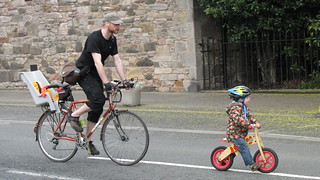There has been something thing bothering me about the recent changes to the policy on cycling in Scotland (well actually there is a lot that bothers me about the policy on cycling in Scotland, but that's why we have PoP) and it has to do with the emphasis on commuters. Have you noticed the way in which the 10% of all journeys keeps becoming 10% of commuter journeys by bike? As if the only journeys which are important in peoples lives are the ones to and from work.
Then this evening, reading a blog post by Rachel Aldred I found the ideal why of challenging this subversion of policy. She points out that an adult centred commuter journey target is fundamentally sexist, her argument is "that getting children cycling is good in itself; moreover, child-friendly infrastructure should mean universal design that works well for everyone. But thinking about connectedness, if we care about adults cycling, we have to care about children cycling. Otherwise, we are limiting cycling for adults to those journeys they make without children. And this has equalities implications. Given unequal childcare responsibilities, we are then restricting women more than men. Single parents, overwhelmingly women, are disproportionately affected. Need to drop your children off at the workplace nursery, or at a school on your way to work? Sorry, the infrastructure wasn’t built for you to do that, we’ve been planning for our ideal commuter, and he doesn’t have any childcare or shopping responsibilities (or any other messy non-work life which spills over into his work trips)."
Therefore such a policy discriminates against women and should be deemed illegal. I think this is a point we need to put forward strongly when ever there is any suggestion that cycling is just about commuter journeys.

 posts
posts
